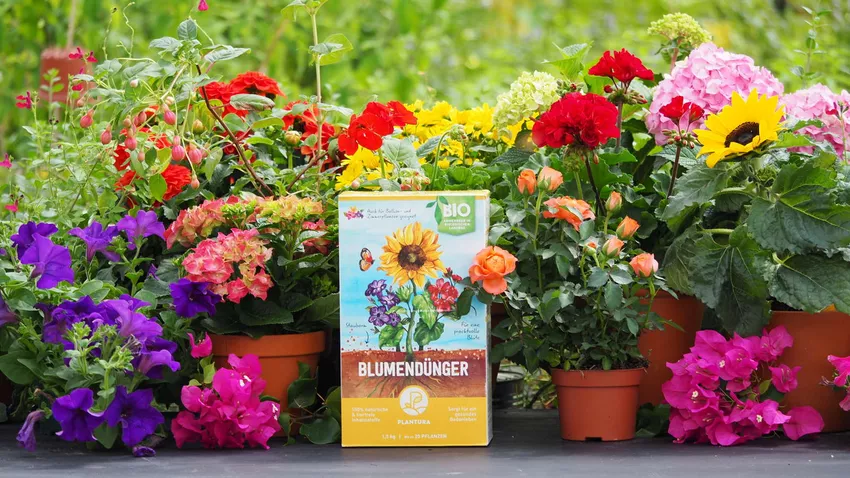Proper fertilization is essential to ensure that the garden blooms plentifully. We show what flower fertilizer consists of and why it is so important.

Of course, harvesting your own vegetables and fruit or a dense lawn are something very nice. But what pleases the eye more than colorful blossoms, which are danced around by bees and butterflies and also smell wonderful? Anyone who owns a flower garden has paradise on their doorstep, always has a bouquet of flowers ready as a gift - and should rely on the right fertilizer. Because the extravagant flowering plants are very demanding.
We explain why the colorful beauties need a special fertilizer, what it can consist of and what the advantages and disadvantages of mineral, organic and organo-mineral fertilizers are.
Why do flowers need special fertilizer?
The term "flower" does not exist in technical jargon, so what is a flower fertilizer? In general, one always speaks of flowers when annual cultivated flowering plants are meant. Perennials and biennial plants can also be included here, but they are only left on an area for one year.

Summer flowers need a special fertilizer for the following reasons:
- Summer flowers are often demanding exotic species that have been bred to produce a rich bloom. The numerous flowers also cause the high nutrient requirement
- Professionally produced summer flowers are used to high levels of nutrients and optimal growth conditions
- When planted outdoors, summer flowers experience a real plant shock, optimal soil preparation and nutrient supply can help to alleviate this
- The root system of summer flowers is not nearly as strong and efficient as that of perennials, which is why good availability is all the more important
- Summer flowers sometimes undergo massive vegetative growth spurts within a very short time, which further increases their need. Agood example is the sunflower
- Most of the summer flowers need the main nutrients nitrogen, phosphate and potassium oxide in a ratio of 9:3:14, so that a corresponding special fertilizer is recommended
What is flower fertilizer made of?
Flower fertilizers are offered as mineral, organic, organo-mineral or organic fertilizers. In addition to the main nutritional elements mentioned above, other nutritional elements are often also included. While mineral fertilizers only contain nutrient s alts in a concentrated form, organic fertilizers also add structural material to the soil fertilization. All types of flower fertilizers have their advantages and disadvantages, so we draw the comparison below.
Test of flower fertilizers
In order to meet the high demands of the spoiled summer flowers and to be able to enjoy their splendor, you should choose the right fertilizer. Your gardening style or your ecological awareness may also play a role in your choice.
Mineral flower fertilizer
Mineral flower fertilizer is available in solid and liquid form. In solid form, the nutrients are present as s alts of the nutrient ions; in liquid fertilizers, these ions are held individually in the aqueous solution by so-called chelates. Mineral fertilizers are often high in nutrients, and the simplest products are quite cheap. What all mineral fertilizers have in common is their very rapid effect, which is suitable for the targeted treatment of acute nutrient deficiencies.

Unfortunately, mineral fertilization also has some significant disadvantages:
- Good solubility can lead to over-fertilization damage and leaching, liquid fertilizers in particular are quickly washed away outdoors and get into the groundwater
- If a soil is only fertilized with mineral fertilizers, its quality will decrease in the long term. Humus is broken down and the important soil life is damaged
- Mineral fertilizers can be contaminated with the toxic heavy metal cadmium, which can get into your garden soil and accumulate there
- The production of mineral fertilizers is energy-intensive and uses limited fossil resources
Organic Flower Fertilizer
Organic fertilizers are shredded waste materials from the food and beverages industry. Animal waste is mostly used for this. Organic fertilizers have a slower rate of action than mineral ones because theNutrients contained in the soil are first unpacked and released by beneficial microorganisms.

You have a high price in relation to the nutrient content, but organic fertilization also brings the following advantages:
- In addition to the main nutrient elements, organic fertilizers always contain various important trace nutrient elements
- The application improves the soil properties, promotes soil life and stabilizes or increases the humus content: This is referred to as soil fertilization
- Slow release minimizes over-fertilization and leaching
- The natural long-term effect takes care of the plants with little effort
- Production requires less energy and recycles nutrients, thus conserving resources
Organic-mineral and organic flower fertilizer
Organic-mineral flower fertilizers and organic flower fertilizers contain both organic and mineral components.
- By combining the opposites, an optimal fertilizing effect can be achieved: A quick effect with simultaneous soil care, the prevention of washing out and over-fertilization, a natural long-term effect and protection of resources
- Classic organo-mineral fertilizers have a lower organic content than organic fertilisers
- Organic fertilizers only use mineral components that are also permitted in organic farming and can even contain living microorganisms
Our Plantura organic flower fertilizer is also such an organic fertilizer. In order to live up to its name, the raw materials used come only from proven organic sources and thanks to the purely plant-based recipe, even a vegan flower lover can use it without hesitation.

Tip: We recommend using an organic long-term flower fertilizer of organic quality. Instead of completely renewing the floor on a regular basis, it is better to take good care of it. Such well-groomed soil can meet the high nutrient and water requirements of summer flowers.